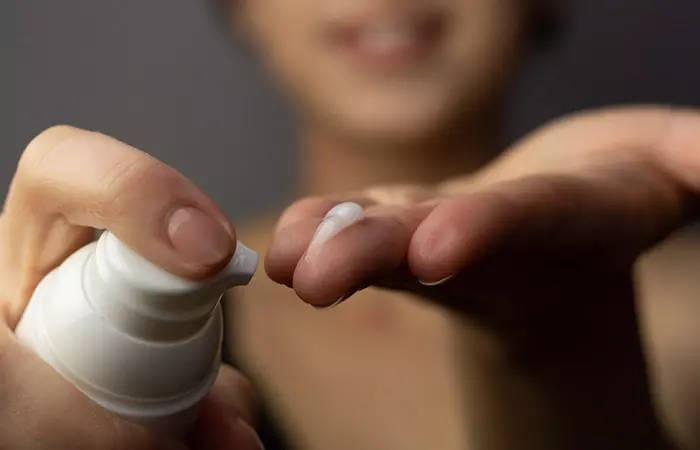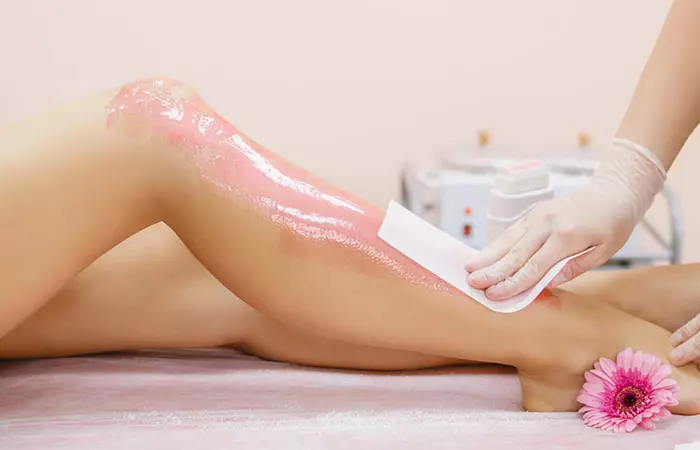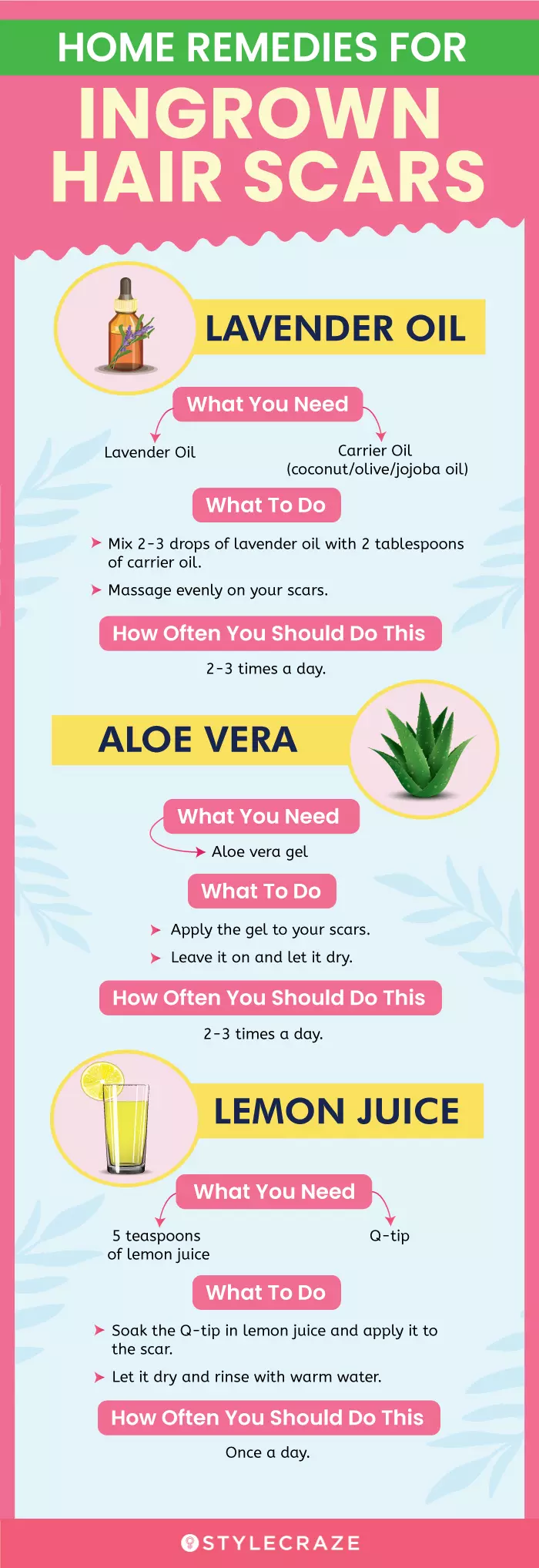Ingrown Hair Scars And Their Causes
An ingrown hair is caused when a tweezed or shaved hair grows back at a different angle, gets trapped under the skin, and appears as a small bump (also called razor bumps). When you try to pluck this hair, it may irritate the skin, causing inflammation, and leave behind scars. Ingrown hair is common in people with dense and thick hair growth and can occur in any body part. It often causes pseudofolliculitis cutis (PFC), a painful inflammation when coarse hair is abruptly removed from the skin and pseudofolliculitis barbae (inflamed follicle) (1), (2). You may develop painful papules over the ingrown hair, which may further turn into pus-containing pustules when you extract the hair by pinching or tweezing. This aggravates the inflammation and irritation. If not treated properly, it may leave behind blemishes and scars. Want to learn how to get rid of ingrown hair scars? Scroll down to the next section for the best solutions.
How To Treat Ingrown Hair Scars
Preventing inflammation and minimizing redness is the best way to prevent scarring. If you have an ingrown hair, do not tweeze or poke that area. Instead, use these remedies:
1. Benzoyl Peroxide
Benzoyl peroxide (as monotherapy) has been found beneficial in decreasing inflammation by minimizing infection. Combining benzoyl peroxide and clindamycin also soothes ingrown hair inflammation and prevents secondary infections (2).
2. Keratolytics
Keratolytics are agents that exfoliate the skin and can help treat various skin conditions, including dermatitis. They can break down the skin cell thickness over the ingrown hair, promote exfoliation to minimize inflammation, and prevent scarring. You can use ingredients like retinoids, salicylic acid, alpha-hydroxy acids (AHAs) like glycolic acid, and chemical peels to soothe inflammation and exfoliate the skin. They also reduce the hair curvature by reducing the sulfhydryl bonds in the hair shafts, reducing the chances of ingrown hair (2).
3. Onion Extract
There is no scientific evidence to prove the efficacy of onion extract in soothing ingrown hair and preventing scars. However, studies found that 12% onion extract gel can prevent scarring caused by surgical wounds (3). Therefore, it may also help prevent ingrown hair scarring.
4. Green Tea
Green tea (Camellia sinensis) contains polyphenols that are potent antioxidants. Green tea polyphenols can effectively reduce skin inflammation and may help improve inflammatory skin issues (4). Applying green tea extract may also soothe inflammation over ingrown hairs, minimize discomfort, and prevent scarring.
5. Silicone Gel
Silicone is an emollient that keeps the skin moisturized, which is crucial for scar management. Silicone gel sheets are widely used to manage scarring (5). You can use silicone products to keep the area moisturized and prevent scarring. If you’ve been wondering how to get rid of scars on the legs or other body parts caused by ingrown hair, then the above remedies are sure to help. If these remedies do not work, there are medical treatments. Read on to learn more about those options.
Medical Treatment Options For Ingrown Hair Scars
Your healthcare professional may provide these medicines to reduce inflammation and fade the scars:
Antibiotic ointment or pills Steroid pills or topical creams
They may also suggest other medical procedures:
Electrolysis: This technique may help fade ingrown hair scars by targeting the hair follicles that cause ingrown hairs. During electrolysis, a thin wire is inserted into the hair follicle, and an electric current is applied to destroy the hair root. Laser Hair Removal: It may help fade ingrown hair scars by targeting hair follicles, preventing new ingrown hairs from forming, and reducing inflammation.
They say prevention is the best cure, and with good reason. With a few simple steps, you can greatly reduce the likelihood of ingrown hair and scarring.
Tips To Prevent Ingrown Hair Scars
1. Avoid Scratching The Hair
If there is ingrown hair on your skin, the best thing to do is leave it alone. More often than not, the issue will resolve itself after a certain period. Even if it does not, picking at it or irritating it will only aggravate the inflammation and lead to scarring. Instead, try to soothe the area or visit a dermatologist for treatment.
2. Follow Basic Skin Care
A simple solution to prevent ingrown hair scarring is to follow a proper skin care routine. Keep the skin moisturized and exfoliate it regularly. Use face and body washes with salicylic acid and AHAs to remove dead skin cells and improve skin texture. This will keep your skin healthy and reduce the chances of ingrown hair.
3. Visit The Salon
If you wax at home, there are greater chances of developing ingrown hair. It is because if the wax strip is not pulled with even force, and if the product is too sticky, it may injure the skin. So, visit a salon and let the experts take care of the procedure. If you are shaving at home, ensure proper precautions are followed and use sharp, single-blade razors to prevent cuts and ingrown hair. You can also use hair removal creams to prevent ingrown hair. A blogger shared her experience while dealing with ingrown hair for more than 6 months on her blog. She said, “I tried to cure ingrown hair and nothing worked – I was fed up. At that time I had a trip to London where I almost cried of the itchiness that I had. And then I knew it was time (i).” She stopped shaving for some time to avoid further irritating her skin. She added, “I did not shave my legs for about 3-4 weeks. I didn’t know what to expect but the results were more than amazing – it sounds so weird but I couldn’t believe I finally have normal, beautiful skin again.” How long does it take for ingrown hair marks to go away? In the infographic below, you will find some easy and effective remedies that can help you deal with ingrown hair scars.Illustration: StyleCraze Design Team It may take a few months to a year for the ingrown hair marks to fade. Do ingrown hair scars go away? No, they may not go away completely. But you can use home remedies or medical treatments to reduce their appearance. Can hair grow where a scar is? After the inflammation or infection subside, hair can still grow in the area. It’s essential to treat ingrown hairs promptly to prevent scarring and further infection. Is it possible to get ingrown hair scars on any part of the body? Ingrown hair scars can develop on any part of the body, but they are more likely to do so in areas that have recently been waxed, shaved, or tweezed. Ingrown hair scars are frequently found on the bikini regions, face, legs, stomach, chin, and inner thigh. Struggling with ingrown hair scars and keloid scars? Discover dermatological solutions to fix them in this informative video. Reclaim smooth and flawless skin. Watch now and take the first step towards confidence!











